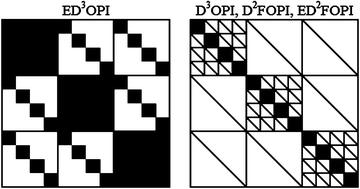Several techniques of varying efficiency are investigated, which treat all singularities present in the triatomic vibrational kinetic energy operator given in orthogonal internal coordinates of the two distances–one angle type. The strategies are based on the use of a direct-product basis built from one-dimensional discrete variable representation (DVR) bases corresponding to the two distances and orthogonal Legendre polynomials, or the corresponding Legendre-DVR basis, corresponding to the angle. The use of Legendre functions ensures the efficient treatment of the angular singularity. Matrix elements of the singular radial operators are calculated employing DVRs using the quadrature approximation as well as special DVRs satisfying the boundary conditions and thus allowing for the use of exact DVR expressions. Potential optimized (PO) radial DVRs, based on one-dimensional Hamiltonians with potentials obtained by fixing or relaxing the two non-active coordinates, are also studied. The numerical calculations employed Hermite-DVR, spherical-oscillator-DVR, and Bessel-DVR bases as the primitive radial functions. A new analytical formula is given for the determination of the matrix elements of the singular radial operator using the Bessel-DVR basis. The usually claimed failure of the quadrature approximation in certain singular integrals is revisited in one and three dimensions. It is shown that as long as no potential optimization is carried out the quadrature approximation works almost as well as the exact DVR expressions. If wave functions with finite amplitude at the boundary are to be computed, the basis sets need to meet the required boundary conditions. The present numerical results also confirm that PO-DVRs should be constructed employing relaxed potentials and PO-DVRs can be useful for optimizing quadrature points for calculations applying large coordinate intervals and describing large-amplitude motions. The utility and efficiency of the different algorithms is demonstrated by the computation of converged near-dissociation vibrational energy levels for the H+3 molecular ion.

You have access to this article
 Please wait while we load your content...
Something went wrong. Try again?
Please wait while we load your content...
Something went wrong. Try again?


 Please wait while we load your content...
Please wait while we load your content...